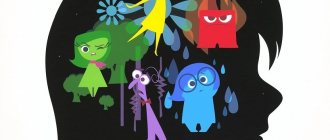Distorted perception, what is it?
Perception is a process during which the human brain receives data from receptors for communication with the outside world.
Most often, this is a sensory perception, starting from the main senses: vision, hearing, smell, touch and taste.
Erroneous perceptions of real things or phenomena are called agnosia .
Distorted perception occurs in two cases: due to incorrect functioning of the sensory organ (receiving an erroneous signal), or due to a mental disorder, character traits or emotional state (erroneous interpretation of the data received).
Sensation disorders – psychosensory disorders
Psychosensory disorder, in particular metamorphopsia, is a disorder of sensation, which is expressed in a distorted perception of the shapes, sizes and spatial arrangement of actually existing surrounding objects.
In the first case, we can say that Alice was dealing with macropsia (the objects around her seemed to her larger than the size they actually are). After eating the pie, it was time for micropsia (they became much smaller than their actual size).
In addition, with such a disorder of sensation, surrounding objects may also change in shape (become curved, diamond-shaped, elongated or bulgy).
There is also dysmorphopsia - with curved shapes and polyopsia , when surrounding objects become larger, optical allesthesia , when it seems that surrounding things begin to move in space, approach the person, put pressure on him, or even press in. Thus, in human perception, the walls can either narrow or move apart, and the floor can move in a wave-like manner.
With psychosensory disorders, not only an altered perception of objects around a person is possible, but also a violation of the “scheme of one’s own body” - depersonalization . That is, the perception of the body as a whole or its individual parts does not correspond to reality.
For example, it may seem to a person that he has absolutely no back or spine, and his head immediately goes into his legs, or that it has reached enormous proportions and fills all the space in the room.
A person may also perceive the location of individual parts of his body distorted (for example, the head ceases to be part of the body or one leg is divided into two).
Sometimes this perception of a "body schema" can disappear when a person consciously focuses his vision and attention on the distorted part of the body. But, as soon as you close your eyes, the erroneous perception returns.
It is important to note that with psychosensory disorders a person perceives real objects and their real appearance.
If the real object is present, but is perceived inadequately (perverted in essence), in a completely different, erroneously distorted form, we are talking about illusions.
Reasons for violation
The most common causes of agnosia:
- damage to the brain structure, cortex due to hemorrhages, severe skull injuries, tumors,
- lack of blood circulation, which results in chronic ischemia,
- Alzheimer's disease,
- Parkinson's disease.
Depending on the cause and the damaged area of the cerebral cortex, a specific perception disorder :
- time (time intervals, deceleration or acceleration),
- visual (hallucinations, illusions, poor spatial orientation),
- reality (complex hallucinations in which several senses are involved, resulting in an extremely plausible image),
- reality (the feeling of being in a dream).
How do perceptual disorders manifest themselves?
The field of psychiatry is a special field of medicine that studies various mental disorders and their manifestations. This is a very specific area of human knowledge, which operates with the concepts of “disease”, “health”, “norm” and “pathology” in relation to mental state. One of the areas of work of a psychiatrist is perceptual disorders. Psychiatry considers such problems to be mental pathologies. Disorders of sensation and perception are manifested by several conditions:
- Anesthesia is manifested by an inability to perceive tactile sensations, taste and smell. Its manifestations are similar to medical anesthesia, which is caused to turn off the sensitivity of pain receptors in patients during medical interventions.
- Hyperesthesia is a sensitivity disorder caused by a seeming increase in smell, light, and sound. Very often, hyperesthesia occurs in patients who have suffered a traumatic brain injury.
- Hypoesthesia is the opposite of hyperesthesia, a change in sensitivity. Sensory perception reduces natural stimuli. Patients with depressive disorders suffer from hyposthesia, for whom the world seems dull and boring.
- Paresthesia is expressed in sensations of itching, burning, tingling, and “pins and needles” caused by impaired blood supply and innervation. Often, paresthesia occurs in the Zakharyin-Ged zones: problems of internal organs manifest themselves in the form of unpleasant, painful sensations in certain areas of the surface of the human body.
- Senestopathies are unpleasant sensations that arise inside the human body; they are difficult to describe in words; most often the patient uses vivid comparative images to talk about these sensations.
“Wrong” sensations sometimes coincide with the clinical manifestations of any disease, and not only from psychiatric practice. A competent diagnosis of a disease or condition is the basis of quality treatment.
Classification of these errors in psychology
The essence of perception is to analyze information coming from outside and compare it with past experience. If errors occur between the points “external stimulus, memory,” this leads to violations.
The first classification of disorders is observed in local (local) disorders of the brain:
- Elementary and tactile (sensory) disorders. Inability to distinguish colors, shades, as well as loss of the sense of heights, smells, etc. These disorders arise due to damage to the analyzer receptors of the cerebral cortex.
- Complex disorders characterized by loss of the ability to perceive objects and the size of the surrounding space.
Gnostic disorders
Gnostic disorders are classified depending on the disorder of a particular organ. There are three main types:
- Visual agnosia. In turn, among visual agnosias there are: object (difficulties in recognizing objects or their photographs), color and font, optical-spatial (problems with understanding perspective, distance of objects from each other)
- Auditory agnosia. Typical problems in this case are difficulties with understanding and remembering live speech and audio melodies.
In his own speech, a person with obvious auditory agnosia loses intonation; in conversation, his voice becomes monotonous, devoid of emotional coloring. I am also unable to sense the intonation patterns of other interlocutors. - Tactile agnosia. Errors in the perception of objects by touch. For example, a person with his eyes closed cannot recognize his own phone or other object that belongs to him personally. Poor spatial orientation is also observed.
Agnosia is a violation in the recognition of previously seen objects, people, faces, even parts of one’s own body.
Main types
Illusions of perception can be of several varieties. The main types include background distortions:
- lack of attentiveness;
- affect;
- pareidolia (the appearance of illusory images when viewing objects);
- optical-geometric distortions.
In addition to optical illusions, other types of illusions may occur:
- sound;
- physiological (for example, after lifting objects of different weights in the right and left hands);
- psychological (related to attitudes);
- verbal (perception of conversations is distorted);
- tactile;
- olfactory;
- taste.
There are also illusions in which the perception of time is disrupted.
Illusions of inattention
This type of distortion occurs when a person is not sufficiently concentrated or lacks information about a subject. The illusion usually appears in conditions that make objective perception difficult - when the room or street is noisy, dark, or the object of attention is at a great distance.
Often, illusions of inattention arise due to the fact that a person has certain expectations and is concentrated on isolating a specific object (sound, image, etc.) from the environment. Thus, a mushroom picker who is determined to have a successful trip to the forest may notice a mushroom under a leaf or branch of a tree. As soon as the mushroom picker switches his attention to other objects, the illusion of inattention arises - he stops seeing the mushrooms.
Representatives of different professions may also experience the illusion of inattention. So, the doctor pays attention to signs of illness noticeable in a person’s appearance and behavior. The photographer evaluates the photogenicity of the client, and the linguist perceives the other person from the point of view of the purity and correctness of his speech.
Psychological attitudes and superstitions are the most common reasons for the appearance of the illusion of inattention in everyday life. So, if a student fails in one subject, then the teacher of this school discipline perceives the student as a failure as a whole.
Illusions of affective nature
A strong emotional shock, reaching the level of affect, can cause illusions of perception. Most often, the emotions that provoke illusions are fear, severe tension, and anxiety.
Under the influence of strong fear, a person who finds himself in the forest at night will see frightening figures in the shadows of bushes and trees; he will perceive the creaking of trees and the rustling of leaves as a threat. Illusions of affect are a normal reaction of a healthy person that arises in a potentially dangerous or alarming situation.
At the age of 4-6 years, children often experience such illusions. They see monsters or other frightening characters in a dark room. For children, the occurrence of such illusions is a normal stage of psychological development associated with the formation of abstract thinking and fantasy.
Mental disorders can also be the cause of affective illusions. Thus, a person with generalized anxiety disorder and a high level of suspicion perceives random glances from passers-by on the street as an attempt at surveillance, and the conversations of other people as a desire to gossip about him.
Pareidolic illusions
Distortions of this type occur when a person examines real objects or images. The appearance of pareidolia cannot be predicted; they occur suddenly.
In most cases, illusory images are fantastic in nature. For example, in a cloud in the sky a person sees figures of animals, outlines of angels, etc.
Often, pareidolic illusions appear against the background of severe alcohol intoxication, after the use of psychoactive drugs.
Pareidolic illusions can be widespread. It happens that a large group of people sees the same images at the same time. This happens when people look at paintings, observe natural phenomena, or look at very famous natural and architectural objects.
One such object that causes mass pareidolia is an image of the Martian region of Cydonia. The photo shows an area with several mesas that form a bizarre landscape. Most people who look at a photograph of Cydonia see a man's face in it.
A similar phenomenon (pareidolia) can be traced in the way people describe clusters of celestial bodies called constellations. Scientists consider the Loch Ness monster, space aliens, ghosts in ancient castles and other paranormal phenomena to be the result of pareidolic illusions of perception.
The exact cause of the pareidolia phenomenon is not known. According to cosmologist Carl Sagan, the ability to recognize images at great distances in poor visibility conditions has been necessary for humans since ancient times. Pareidolia when meeting another person made it possible to understand whether it was one of our own or a stranger, and whether it was worth fearing. In the process of evolutionary development, the recognition mechanism was mastered so well that people learned to notice patterns in objects where they were absent.
The phenomenon of pareidolia is actively used in the creation of advertising products and industrial design. It is believed that objects with outlines similar to a human face or body are better perceived by consumers. The design of the glass bottle for Coca-Cola (Contour Bottle) traces the use of pareidolia in the form of the outlines of a female body.
For consumers to perceive anthropomorphic products well, the outline of a person must be barely visible. If they are too obvious, then the pareidolia product will cause disgust and will seem too intrusive, and sometimes scary.
Robot developers note that the more similar their products are to a living person, the more negative emotions they cause in users. A robot that is as similar to a human as possible is perceived as an anomalous phenomenon or a dead man who has come to life.
Optical-geometric distortions
Illusions of perception can arise due to the anatomical features of the structure and functioning of the eye. The essence of optical-geometric illusions is that the real sizes of objects that a person sees and the perceived ones do not coincide.
The simplest example of an optical-geometric illusion is a picture with drawn lines. They are the same size and have arrows at the ends. The line with the arrow facing inward appears shorter. The one with the end pointing outward appears longer.
The occurrence of optical-geometric illusions is not associated with mental disorders. Distortions are observed by all healthy people, which is why illusions are called physiological.
Causes of illusions of perception
Scientists have not yet provided an explanation for most of the illusions of perception. It is believed that some distortions are related to the integrity of the perception of objects, which is disrupted due to:
- sporadic errors in the functioning of the central nervous system against the background of severe fatigue, stress, lack of sleep, intoxication;
- high sensory load, in which a person is influenced by stimuli simultaneously from several sources. Such irritants may be bright light, high noise levels, high or low air temperature;
- intersensory effect - it occurs when the senses combine and produce a common impression. So, in a good restaurant, a person is influenced by calm, muffled music, the smell and taste of food, and a beautiful interior. Together, all these factors enhance the sensations - food seems even more delicious;
- intersensory interaction - simultaneous coordinated action of the senses, as a result of which a holistic idea of an event or object arises.
The phenomenon of illusion of perception in psychology is also considered as a consequence of mutual stimulation of one sensory system by another. For example, when listening to music, visual images arise.
The cause of illusions can also be psychological and social factors:
- unconscious desires - they become the basis for the formation of a false image of information coming through the senses;
- past experience - a person tends to perceive objects as he is used to seeing, hearing, feeling them;
- emotional state - mood affects how a person perceives the same facts, events, phenomena. Under the influence of heavy emotions, a negative perception of most events and objects is formed.
- personal characteristics, self-esteem, susceptibility or immunity to outside influence - these factors can influence the formation of distortions of perception;
- stereotypes of thinking, stable beliefs - they force a person to consider images, objects and events from a familiar point of view.
In order not to fall into the web of illusions, it is worth considering events and objects from different positions, applying analysis, and, if possible, checking the truth of perception by measurement.
Why is the perception of reality disrupted?
When faced with psychiatric problems, the question arises: what are the causes of perception disorders? There can be a whole range of them: from alcohol and drug poisoning to a pathological state of the human psyche. Mental illnesses are quite difficult to diagnose, often due to the fact that a person cannot accurately describe his feelings, the events that happened or are happening to him, and the initial stages of the disease are not always noticeable to others. Perception disorders can develop as a consequence of any diseases of internal organs or systems, as well as due to disruption of the processes of processing received information, analyzing it and obtaining a specific result. Psychiatric practice at the moment cannot absolutely accurately determine the causes of the development of perception disorders, except for intoxication, when the mechanism of pathology is precisely determined by the toxic substance. Disturbances in the perception of reality can and should cause caution among people around them, since often the patients themselves are in no hurry to turn to specialists, not considering these disturbances as something pathological. A timely identified problem with the perception of surrounding reality can help the patient avoid serious problems. Distorted reality is a huge problem both for the patient and for the people around him, both mentally and physically.
Pseudoagnosia in dementia (False misrecognitions in dementia)
A study of visual perception in patients whose clinical picture and experimental psychological studies revealed dementia of the organic type revealed the above-mentioned features: the patients did not recognize silhouette and dotted patterns. But another feature was added to this: their perception was diffuse, undifferentiated. The object of recognition was determined by the part of the drawing on which the patient fixed his attention. Let us give the most striking examples according to B.V. Zeigarnik.
Example 1. A patient calls a mushroom a tomato if he looks at the head of the mushroom, or sees a cucumber in the mushroom if he fixes his attention on its stem. Therefore, when presenting a drawing to a patient, it is often indifferent whether they show him part or the whole of it.
In some patients, agnosia extended to both the structure and shape of the image.
Example 2. When shown a triangle, the patient says: “Something like a wedge, but I can’t call it, I see a wedge in three places, a wedge-three-wedge.” When exposing the quadrilateral, the patient says: “It’s hard for me to say (circles with a finger) - straight, straight, straight and straight.” When exposing an unfinished circle, he sees first of all the flaw: “There is some kind of failure here,” while at the same time he perceives the symmetry of the form. For example, when showing a cross, not being able to name the figures, the patient declares: “Look wherever you want, it lies correctly.”
Example 3. When examining a picture of a peasant standing with a thoughtful look by a cart whose wheel has bounced off, the patient says: “Here is the wheel, and this is a man standing.” Pointing to the horse, he says: “And this is some kind of bird.” Experimenter: “It’s a horse.” Patient: “It doesn’t look like a horse.”
In these examples, there is a clear violation of not only the semantic, but also the structural components of the drawing. When trying to understand the plot of a picture, patients often incorrectly describe its content due to incorrect recognition of details and structural decay. This disorder resembles the phenomenon described by A. Pick as “senile agnosia” or as a disorder of “simultaneous perception”. It is expressed in the fact that the subject, while describing individual objects, is unable to grasp the general meaning of the picture.
As we see, the disturbance of perception that is found in mentally retarded patients confirms the leading role of meaningfulness and generalization in any act of perceptual activity. Thus, pathological material reveals the integrity of mental (reflective) activity. The considered disturbance of perception is, in fact, a violation of mental operations - synthesis and generalization.
Pathologies of sensory cognition
Disorders of various types of sensory cognition include distortions of several processes in the human body: sensations, perceptions, ideas. And they are also usually divided into different types.
Changing sensitivity
{banner_banstat9}
Such variation is possible both downward and, conversely, upward. Human states are different and have their own scientific designations.
Mental hyperesthesia is a sharp increase in sensitivity even with minimal exposure to a stimulus. Sensations of smell, taste and light, which were previously normal, now cause discomfort and even pain.
The following manifestations are also noted:
- incontinence;
- anger;
- irritability;
This pathology of sensory cognition is associated with the development of the following diseases:
- amentia;
- oneiroid;
- hallucinosis;
- paranoid;
- neurotic syndromes;
- acute intoxication with strong drugs, drugs, alcohol;
- damage to the peripheral nervous system (if hypersthesia is observed on the skin).
Decreased sensitivity, in turn, has two types of disorders.
Mental anesthesia is a pathology of perception in the absence of a reaction from one of the analyzers:
- blindness;
- loss of sense of taste;
- immunity to odors;
- deafness;
- disappearance of the sensation of pain.
Only a slight drop in the level of sensitivity is called hypoesthesia.
Senestopathies are sensations that are difficult to define. They have no basis and no clear location; they are unpleasant and painful.
Classified as follows:
- thermal (burning or cold feeling);
- movement, movement of tissues (twisting, joining or delamination);
- tension;
- sensation of pulsation, transfusion;
- drilling and tearing, burning pain.
Most often, the patient determines the location of such sensations in the brain area. May occur in the chest as well as the abdominal cavity. Extremely rare - in the upper and lower extremities.
As long as we feel, we live
If perception is a holistic picture-representation of the surrounding world, then sensation is the process of displaying individual qualities and properties of objects as a result of their impact on the human senses.
Only those living beings that have a nervous system have the ability to gain such experience. Awareness of sensations comes with the presence of a brain.
Sensation is the initial link in a person’s knowledge of both the external and internal world.
The stimuli that provoke this phenomenon are different, hence the existence of different types of sensation:
- visual;
- cutaneous;
- auditory;
- associated with the muscle system and internal organs.








